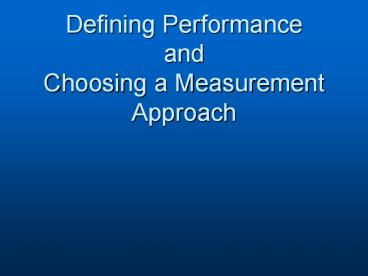Defining Performance and Choosing a Measurement Approach - PowerPoint PPT Presentation
Title:
Defining Performance and Choosing a Measurement Approach
Description:
Defining Performance and Choosing a Measurement Approach Overview Defining Performance Determinants of Performance Performance Dimensions Approaches to Measuring ... – PowerPoint PPT presentation
Number of Views:599
Avg rating:3.0/5.0
Title: Defining Performance and Choosing a Measurement Approach
1
Defining Performance and Choosing a Measurement
Approach
2
Overview
- Defining Performance
- Determinants of Performance
- Performance Dimensions
- Approaches to Measuring Performance
3
Defining Performance
- Performance is
- Behavior
- What employees do
4
Defining Performance
- Performance is NOT
- Results or Outcomes
- What employees produce
5
Behaviors labeled as Performance are
- Evaluative
- Negative
- Neutral
- Positive
- Multidimensional
- Many different kinds of behaviors
- Advance or hinder organizational goals
6
Behaviors are Not always
- Observable
- Measurable
7
Results/Consequences may be used
- To infer behavior
- As proxy for behavioral measure
8
Determinants of Performance
Performance Declarative Knowledge X
Procedural Knowledge X Motivation
9
A. Declarative Knowledge
- Information about
- Facts
- Labels
- Principles
- Goals
- Understanding of task requirements
10
B. Procedural Knowledge
- Knowing
- What to do
- How to do it
- and
11
Procedural Knowledge (continued)
- Skills
- Cognitive
- Physical
- Perceptual
- Motor
- Interpersonal
12
C. Motivation
- Choices
- Expenditure of effort
- Level of effort
- Persistence of effort
- (Deliberate Practice leads to excellence)
13
Deliberate Practice
- Approach performance with goal of getting better
- Focus on performance
- What is happening?
- Why?
- Seek feedback from expert sources
- Build mental models of job, situation,
organization - Repeat first 4 steps on an ongoing basis
14
Implications for Addressing Performance Problems
- Managers need information to accurately identify
source(s) of performance problems - Performance management systems must
- Measure performance
- AND
- Provide information on SOURCE(s) of problems
15
Factors Influencing Determinants of Performance
- Individual characteristics
- Procedural knowledge
- Declarative knowledge
- Motivation
- HR practices
- Work environment
16
Performance DimensionsTypes of
multi-dimensional behaviors
- Task performance
- Contextual performance
- Pro-social behaviors
- Organizational citizenship
17
Task performance
- Activities that
- transform raw materials
- help with the transformation process
- Replenishing
- Distributing
- Supporting
18
Contextual performance
- Behaviors that
- contribute to organizations effectiveness
- and
- provide a good environment in which task
performance can occur
19
Differences Between Task and Contextual
Performance
- Task Performance
- Varies across jobs
- Likely to be role prescribed
- Influenced by
- Abilities
- Skills
- Contextual Performance
- Fairly similar across jobs
- Not likely to be role prescribed
- Influenced by
- Personality
20
Why Include Task Contextual Performance
Dimensions in PM system?
- Global competition
- Customer service
- Teamwork
- Employee perceptions of PM
- Supervisor views
21
Job Performance in Context
That produce various results
A performer (individual or team)
Engages in certain behaviors
In a given situation
TRAIT
BEHAVIOR
RESULTS
22
Approaches to Measuring Performance
- Trait Approach
- Emphasizes individual traits of employees
- Behavior Approach
- Emphasizes how employees do the job
- Results Approach
- Emphasizes what employees produce
23
Trait Approach
- Emphasis on individual
- Evaluate stable traits
- Cognitive abilities
- Personality
- Based on relationship between traits performance
24
Trait Approach (continued)
- Appropriate if
- Structural changes planned for organization
- Disadvantages
- Improvement not under individuals control
- Trait may not lead to
- Desired behaviors or
- Desired results
25
Behavior Approach
- Appropriate if
- Employees take a long time to achieve desired
outcomes - Link between behaviors and results is not obvious
- Outcomes occur in the distant future
- Poor results are due to causes beyond the
performers control - Not appropriate if
- above conditions are not present
26
Results Approach
- Advantages
- Less time
- Lower cost
- Data appear objective
27
Results Approach (continued)
- Most appropriate when
- Workers skilled in necessary behaviors
- Behaviors and results obviously related
- Consistent improvement in results over time
- Many ways to do the job right
28
Quick Review
- Defining Performance
- Determinants of Performance
- Performance Dimensions
- Approaches to Measuring Performance






























